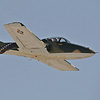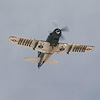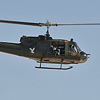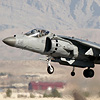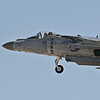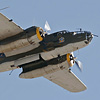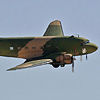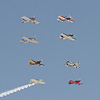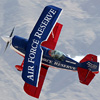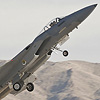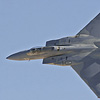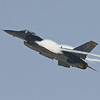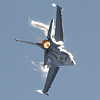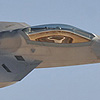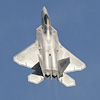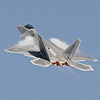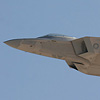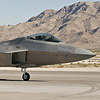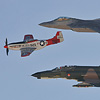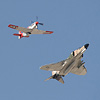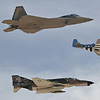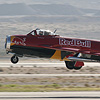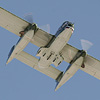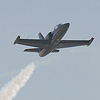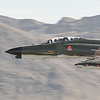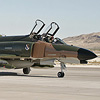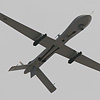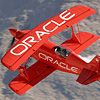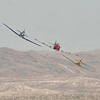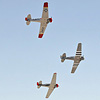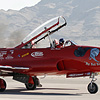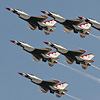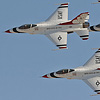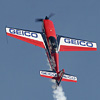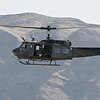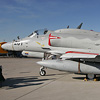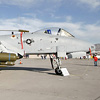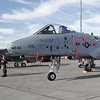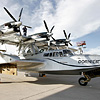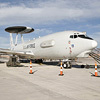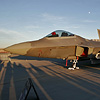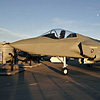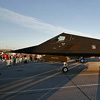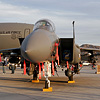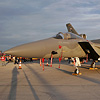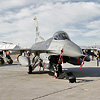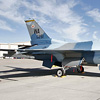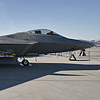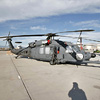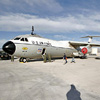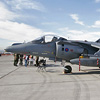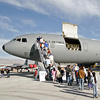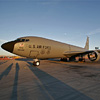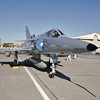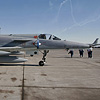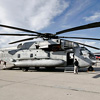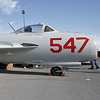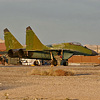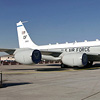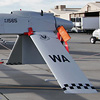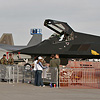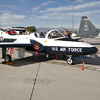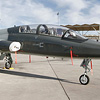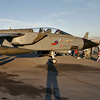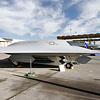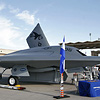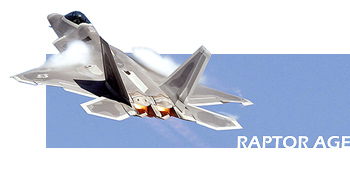
Nellis AFB Aviation Nation Air Show 2005 Review
Saturday 12th November - Sunday 13th November
As the very last airshow of the year in the United States, Nellis is the last chance the enthusiast has to enjoy some of the top military and civilian displays in the US before the winter shuts down everything until the following year. 2005 in particular was a banner year for Aviation Nation, as the airshow is known. As an important part of Las Vegas' Operation Welcome Home celebrations, which also included a visit by The Moving Wall (a half-scale replica of the Vietnam Memorial in Washington, D.C), the Las Vegas Veterans Day Parade, and the Freemont Street Patriot Party in historic downtown Las Vegas, Aviation Nation honoured the 2.7 million US servicemen who took part in the Vietnam war, where US involvement ended exactly 30 years ago. But the highlight of the show was not an aircraft form the past, but from the future - the F-22A Raptor, which for the first time offered a glimpse of its amazing performance to the public.
recalls some of his experiences from the last airshow he attended in 2005. All photographs by the author.
It's hard to find these days anyone who follows airshows who has not heard anything about the annual event staged at Nellis AFB, a major USAF base situated a few miles north of Las Vegas. Actually, most people will tell you that it's a great airshow, known for providing year-in and year-out one of the best-rounded lineups of military and civilian flying displays, and superb variety on the ground. I had just once had the chance to attend Nellis in the past (USAF 50th Anniversary Airshow in 1997 - couldn't have chosen a better year), and was impressed by the astonishing variety of aircraft I had the chance to see then, including the now-retired SR-71 Blackbird. So it was time to pay Nellis AFB another visit, and the prospect of seeing a Raptor in the air again was the reason I needed to take a few days off work and head to the desert.
Being so close to Las Vegas, the airshow brings a lot of attractions to the public, most of which are to be enjoyed after the sun goes down if one decides to take full advantage of the night life at the Strip! As a married man and dedicated UKAR Crew Member, however, I concentrated my efforts on the airshow (OK, OK, I spent the nights gambling a little bit), but where else there are so many things to do to complement your airshow experience in the world? Besides, having so many casinos and businesses so close help the airshow to get the needed sponsors to help pay all the costs involved, starting with the shuttle buses which brought the public from the Las Vegas Motor Speedway to the base. I can't really understand why there are people who don't like off-base parking. Like at JSOH earlier this year, the shuttle buses were available in abundance, and they definitely help minimize the traffic problems that invariably would occur if cars were allowed to park on the base.
After the bus driver got lost during the short shuttle from the speedway to Nellis on Saturday morning, on arriving at the base I was greeted by a sight I really wasn't expecting to see: a olive drab MiG-29 "Fulcrum-C" (izdeliye 9.13), most probably one of the many the USAF purchased from Moldova a few years ago. It didn't seem to be airworthy anymore, but it made you remember that Nellis is home to the U.S. Air Force Warfare Center, which is tasked with testing, tactics development, and advanced combat training. Entering the gates, one could see several examples of the aircraft that compose the wings associated with it on the static displays: the F-15C/E, the A-10/OA-10, the F-16C, the HH-60G, and the RQ-1. By the way, the beautifully camouflaged 57th Adversary Tactics Group F-16C parked on the statics, a personal favorite of mine, was even surrounded by some former Soviet-bloc equipment: a MiG-17F, a SA-8 Gecko, and the universally known SS-1B Scud missile. After not seeing much at Oceana in September in the statics, it was refreshing to see so many interesting displays at Nellis two months later.
And probably the most interesting static display was the one found in the far end of the flightline, where a F-22A, a F-35 mock-up, and a F-117A were parked together in a "stealth row". The first thing that jumps to your mind is how much the stealth technology has evolved in the last 20 years, since engineers can now design the airplane with stealth characteristics rather than starting with stealth features and try to make an airplane out of them! Also of note in the statics was C-141C "Hanoi Taxi", the first one to land in Hanoi during the Vietnam War, and one of the last ones in service with the USAF. The British were also well represented at the show with a GR.4 Tornado and, surprisingly, a brand new Harrier GR.9A, both from the FJWOEU. A pair of civilian-owned Kfirs and a civilian A-4N, a RC-135V Rivet Joint, a Do-24TT, no less than three UCAVs (X-45 and X-47 mock-ups, and a RQ-1), a KC-135R, an E-3 AWACS and a slew of warbirds rounded the static displays, which were one of the highlights of the show.
The flying displays started each day with the USAF F-16C West Coast Demo Team, whose pilot this year is Capt. Dax "Mojo" Cornelius from the 388th Fighter Wing, Hill AFB. It is now widely accepted that the USAF Viper displays are not on a par with the European ones, particularly the Dutch display, but it's still a very good one. Capt. Cornelius flew a mix of close air support and air superiority maneuvers during his display, which was enhanced by plenty of vapour (in the desert, no less!) during some of his high-G maneuvers. Here the main negative factor of this otherwise great event reared its ugly face: the sun. Although it's not as bad in the afternoon, one is shooting the whole day with the sun in one's face, making photography quite difficult. On the other hand, although there are many airshows where the sun is at your back, it's hard to find a place with so beautiful a background to shoot your pictures against, especially when the sun is illuminating the mountains nearby Nellis.
A pair of B-25 Mitchells, "Heavenly Body" and "Executive Sweet", reenacted the Doolittle Raid soon thereafter, and plenty of pyro was used to simulate the bomb runs performed by these warbirds. They were followed by Chris Rounds' "Red Knight" T-33, which has returned to the airshow circuit last year since being grounded after the death of its former owner in 1993. The T-33, in its heyday, was an impressive machine, but nowadays it pales in comparison with any modern-day fighter, and coming just a few minutes after the Viper demo didn't help Mr. Rounds' performance one bit. The same thing can be said about Bill Reesman's MiG-17F Fresco performance, although, for starters, he has much more thrust to play with. I have to say I was slight disappointed after he landed his MiG, since he used to engage reheat all the time in the past, but didn't appear to do that even once this year. The maneuvers are also much blander, although that probably can be explained by the myriad of incidents he has had during this season, especially at Miramar in October.
The next display was one I didn't expect much to start with, and my expectations were met when the aircraft that took part in it started racing each other. The Formula One Air Racing Demonstration, as it's known, is performed by aircraft built specially for speed, and it might be a very interesting event at Reno, where the pilots are actually competing against each other and shoving the throttle to the floor. Not so at Nellis, where the pilots had nothing to compete for. To top it off, the aeroplanes' small size didn't help against the vast desert expanses, a problem that was magnified due to the fact they appeared to be flying farther away from the flightline than the other displays. It's not the pilots' fault, of course, but it was definitely not the most entertaining performance of the day.
The Patriots Jet Demonstration Team followed the so-called "race", and I was pleasantly surprised with them, being the first time I had the chance to see their three L-39Cs displaying. This display is flown and led by Lt. Col. Dean Wright, a former Thunderbirds' solo pilot and a current F-117 Nighthawk pilot, by right wing pilot Volodymyr Chetverous, an Ukrainian who has twice won aerobatic competitions in the former Soviet Union and a former right wingman of the Soviet Aerobatic Team RUSSJ (which flew L-39s), and by left wing pilot John Posson, an United Airlines B-737 captain. A slew of the beautiful choreographed maneuvers and some solo stunts are flown by the L-39s, including the unique tail slide, which very few western jets are capable of matching. Couple their precision flying with the use of coloured smoke, and you have one of the really good surprises of the US airshow circuit in the last couple of years.
The Vietnam Airpower Demonstration, part of the larger Vietnam celebrations aforementioned, didn't disappoint either. Here, an AT-37 (Vietnam callsign "Dragon"), two AD Skyraiders (callsign "Sandy"), an OV-10 Bronco (callsign "Nail"), a DC-3 disguised as an AC-47 (callsign "Spooky"), two UH-1 (callsign "Jolly") and a AH-1 took their turns over the runway to simulate both CAS (close air support) and CSAR (combat search and rescue) missions. Again, plenty of pyro was employed to enhance their performance, the end result being quite nice. Tim Weber's GEICO Extra 300 flew next, and after it landed it was time to run for the food stands to grab something to eat while the Thunderbirds were performing their mid-morning engine runs. Sometimes I wonder if that's something really needed, since I don't recall any other jet team in the world (including the Blue Angels) that requires a prime time window during the airshow to test their engines. Do you?
The Patriots Jet Demonstration Team followed the so-called "race", and I was pleasantly surprised with them, being the first time I had the chance to see their three L-39Cs displaying. This display is flown and led by Lt. Col. Dean Wright, a former Thunderbirds' solo pilot and a current F-117 Nighthawk pilot, by right wing pilot Volodymyr Chetverous, an Ukrainian who has twice won aerobatic competitions in the former Soviet Union and a former right wingman of the Soviet Aerobatic Team RUSSJ (which flew L-39s), and by left wing pilot John Posson, an United Airlines B-737 captain. A slew of the beautiful choreographed maneuvers and some solo stunts are flown by the L-39s, including the unique tail slide, which very few western jets are capable of matching. Couple their precision flying with the use of coloured smoke, and you have one of the really good surprises of the US airshow circuit in the last couple of years.
The Vietnam Airpower Demonstration, part of the larger Vietnam celebrations aforementioned, didn't disappoint either. Here, an AT-37 (Vietnam callsign "Dragon"), two AD Skyraiders (callsign "Sandy"), an OV-10 Bronco (callsign "Nail"), a DC-3 disguised as an AC-47 (callsign "Spooky"), two UH-1 (callsign "Jolly") and a AH-1 took their turns over the runway to simulate both CAS (close air support) and CSAR (combat search and rescue) missions. Again, plenty of pyro was employed to enhance their performance, the end result being quite nice. Tim Weber's GEICO Extra 300 flew next, and after it landed it was time to run for the food stands to grab something to eat while the Thunderbirds were performing their mid-morning engine runs. Sometimes I wonder if that's something really needed, since I don't recall any other jet team in the world (including the Blue Angels) that requires a prime time window during the airshow to test their engines. Do you?
Casting aside my wonderings, let's continue with the flying displays. A huge flock of aeroplanes, mostly homebuilts, took part in the next display in the schedule, the EAA Formation. Maj. Ed Hamill, an USAF Reserve F-16 instructor at Luke AFB, followed them with the Air Force Reserve Above and Beyond Aerobatic Show. Flying the "Dream Machine", a +6/-5G stressed Curtiss Pitts, he performed knife-edge passes, tumbles, double hammerheads and torque rolls. A huge roar from several radial engines could be heard after his display, provided by the many T-6s that took part in the T-6 Air Racing Demonstration. Although again there was no actual racing between the planes involved, I enjoyed that display much more than the one provided by their Formula One counterparts. I concede I have a bias towards the T-6 (it's one of my favorite aircraft), but just witnessing the reaction of people surrounding me, I believe my opinion was shared by most who were there.
Plenty more noise was provided by a US Marine Corps' AV-8B Harrier from MCAS Yuma-based VMA-311 Tomcats. The US Harrier demo has always been better than the British one, and this particular one proved to be no exception to the rule. I still wonder why the RAF doesn't allow its display pilots to take-off and land vertically during the Harrier demo, something you always get from an USMC AV-8B, regardless of altitude or temperature. The top aerobatic pilot in the US followed him in his bright-red Oracle Challenger, and again his display was by far and away the best one of the airshow in his class. Sean D. Tucker's Sky Dance routine is probably the most G-loaded demo in the entire airshow industry, subjecting his body to +12 to -7.5G forces! To achieve that, he flies an aeroplane designed and built for him, which is powered by a modified Lycoming AEIO-540D4B5, capable of producing more than 400 horsepower. That is probably the only aerobatic demo I never get tired of seeing, and the one I follow from the beginning to the end. He's that good!
But the organizers saved the best they had to offer for last. Taking off after the aircraft that would later fly the Heritage Flight had departed, Maj. Jason "Bondo" Costello provided once more a top Eagle demo. Soon, however, such demos will become only a distant memory, because the F-15C East Coast Demo Team is scheduled to be replaced, due to the arrival of new Raptors at Langley AFB, by a F-22 Demo Team in 2007. Talking about the Raptor, an F-22 performed, for the first time ever, more than straight passes along the flightline. Particularly impressive was the pull-up after the aircraft left the ground, where one could see how its thrust-vectored engines allow it to point its nose up with amazing ease and quickness. Having 70.000+ pounds of thrust available allowed it to skyrocket at a pace no operational F-15 would be able to match. Later, the "banana" pass was performed with only one engine in reheat, and comments were made stating that, if both engines were so employed, it would probably break Mach 1. Pretty impressive if it's true, but it comes to be expected when talking about such an impressive machine.
The Heritage Flight formations represented probably the highest point of the show, placing together three of the best aircraft of their respective generations: the F-22 Raptor, the F-4 Phantom, and the P-51 Mustang. Although Maj. Michael Shower and Lt. Col. Chuck Hainline flew both days with the Raptor and Phantom, respectively, the P-51 pilots took their turns: Maj. Gen. Bill Anders flew P-51D "Val-Halla" on Saturday, and Mr. Chuck Hall flew P-51D "Six-Shooter" on Sunday. Just to see a Phantom in the air is good enough, but an F-4 together with a F-22 and a P-51 is much better…
After the Heritage Flight landed, a very special show in honour of all Vietnam vets was hosted by Nellis AFB. Acclaimed US singers like Paulette Carlson and Hank Brake took part in the USO Show, which was staged to thank all US servicemen that took part in that conflict. And, as it's the norm at all US airshows where they take part, the Thunderbirds closed the festivities both days. Nellis not only represented their final official airshow demonstrations in 2005, but also their home airshow, providing the pilots a chance to perform before their friends and family. I must say here I was impressed by the quality of their display, which was significantly better than the one I had seen in May. Bolstered by the arrival of a new #3 (right-wing) pilot, Capt. Chris Callaghan, the Thunderbirds provided a seemingly flawless display, which was enhanced by the late afternoon sun.
There's one final aircraft I haven't mentioned that took a very active role during the airshow, but whose presence was only seen briefly both days: the RQ-1 Predator. One can't really comprehend how impressive it was to see, for example, the F-16 performing its demo over the runway from above. Two really large screens at the end of the flightline received real-time footage from the Predator above, and there was no detail it failed to reveal, although one would never know it was recording everything from up there. After such a display of cutting-edge technology, I understand why UAVs are the wave of the future, although I'll definitely miss seeing a man inside the aircraft's cockpit. Fortunately, there were still plenty of them to be seen at Aviation Nation 2005, a great show that provided a fitting end to a great airshow season.

